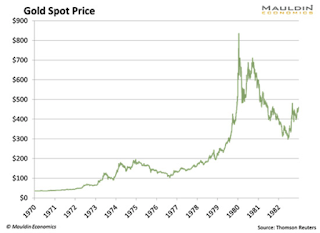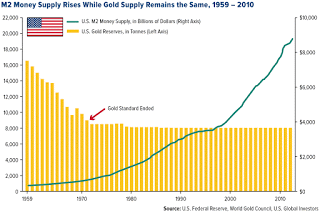In Defence of Shiny Things

In Defence of Shiny Things
Have you ever wondered how the dollar derives its value? After all, the green piece of paper that its printed on isn't inherently valuable. To better understand the topic at hand, let's journey back in time.
Prior to 1933, the United States used what is known as a "Gold Standard" to establish the value of the dollar. In this monetary system, a country's currency is backed by the physical commodities of gold, silver, and other precious metals. At the time, the amount of circulating paper money was equal to the reserve supply of gold/silver. For example, if on the gold standard, gold was valued at $25/oz, one dollar could be exchanged for 1/25oz of gold.
...but this all changed when the financial fears of the Great Depression gripped the very heart of the American consumer. In response to the chaotic market crashes and turbulent economy, no longer did the citizens of the United States trust their government to honor the exchange of dollar for gold. Instead, citizens preferred to hold tight and hoard gold, recognizing and valuing its intrinsic worth over the dollar.
In response, and due to the fear of citizens making a run on the banks (everybody exchanging their dollars for gold at the same time, depleting federal reserves of their precious metals), in March of 1933, President Roosevelt ordered a nationwide moratorium prohibiting banks from paying out in gold. Then in April of 1933, President Roosevelt decreed that all gold coins, bullion, and certificates in denominations of more than $100 be turned in for other money (dollars). By May 1st of 1933, the law required all persons to exchange their gold assets for dollars at a fixed rate of $20.67/oz- effectively outlawing the private ownership of gold. One year after the government led plundering of private citizen wealth (things have not changed much since then...) the government raised the price of silver to $35/oz, increasing the government reserves net worth by a whopping 69%.

The United States maintained these laws until 1971 when president Nixon declared that the United States would no longer maintain the fixed value of gold at $35/oz. Then, in 1974, when gold had increased its value six-fold up to $183.77oz, and the government still controlled all of the gold, President Gerald Ford signed legislation once again allowing private ownership of gold. The government being the only entity which held gold at the time was the sole point of sales, profiting massively off of the citizenry legally purchasing gold for the first time in 40 years.
...But that was then...
Today, not a single government uses a Gold Standard. Instead, the governing bodies from around the world implement fiat. Fiat is defined as any money that the government declares as legal tender. This type of money is not backed by a physical commodity like gold or silver. Plainly stated, fiat money has no intrinsic value. Instead, the value is determined by market forces and by a country's GDP.
So why does a ten dollar bill have value and other pieces of paper do not? For starters, our current monetary system works on a set of principles that money is both a good and a medium of exchange.
As a good, we have to mutually agree and believe that fiat money is worth something. The green slip of paper derives its value because we agree that it is worth a certain amount. As an example, often times in films, cigarettes are portrayed as money in prison systems. We all intuitively understand how this tobacco based economy would work. Prisoners value the smokes and therefore exchange them for other goods and services (2 packs per shanking, last I've heard).
As a medium of exchange, we choose to use money because it is very efficient. Let's face it, civilization is not going to back-pedal and use the bartering system. Imagine how impractical that would be (Thank you for choosing Best Buy, your new 65" QLED Smart TV will be 28 chickens, 7 iron nails, and a month's supply of firewood).
Previously stated, fiat money derives its value from market forces and the country's GDP. Nations which are wealthier will generally have fiat money which is worth more when compared to the fiat money of a country which is poor. In the United States, the dollar is backed by "the full faith and credit" of the government. But how much is that faith and credit worth? After all, both are intangibles and both only go as far as our trust in them.

Lastly, there are many hidden consequences which are associated with fiat currencies
(1) Fiat money has no intrinsic worth and relies on the fact that citizens trust the government not to manipulate it.
(2) Because it is decoupled from a physical commodity, there is little to stop the government from inflating the supply of fiat; "printing" more money.
(3) Fiat loses value over time- ALWAYS. With new money being printed on a yearly basis to replace damaged or lost bills, the government always prints more than needed, driving down the value.
(4) The value of fiat has the potential to drop to ZERO. After all, it's just paper. For further evidence, see: Venezuela.
Due to the downfalls and drawbacks associated with how the value of the dollar is derived today, policy makers and citizens alike should begin to question our current monetary system and possibly look to the past for sound solutions. When all of the smoke and mirrors are cast aside and the truth is left standing naked, "faith and credit" backing fiat money are of little to no worth.
This thing looks really good for long term
Agreed. I believe 2022-2023 will be a good year for gold and silver prices.
Hi! I am a robot. I just upvoted you! I found similar content that readers might be interested in:
https://deviantperceptions.blogspot.com/2018/10/in-defence-of-shiny-things.html
That's from my blogspot.com website for anybody who might be interested! :)